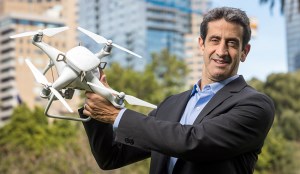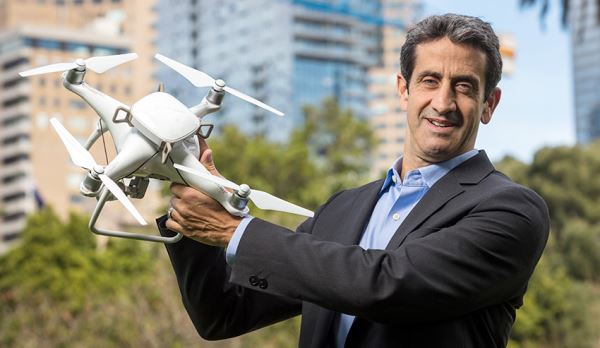The global commercial and recreational drone market is reaching dizzying heights.
An estimated 29 million drones will be buzzing across the sky by 2021 – including more than 800,000 new commercial drones within the next 12 months.
The explosion in drone numbers brings with it worldwide moves to implement strict new drone safety laws.
Recent incidents where rogue drones have forced the shutdown of major airports – including Gatwick in London and Dublin Airport in Ireland – have further fuelled the need for new regulations.
The US Federal Aviation Administration (FAA) recently unveiled a set of proposed regulations designed to improve drone safety.
And jurisdictions across the globe – including the Civil Aviation Safety Authority (CASA) in Australia – are expected to follow suit in coming months.
Routine flights over people
Under the new regulations, routine flights over people and at night would be permitted for the first time – provided strict new safety precautions are met.
Previously, drone operations in urban areas, such as flying over construction sites and delivering packages has been banned in many jurisdictions without special waivers.
This has stifled growth in the unmanned aircraft industry.
But under the proposed FAA rules, regulation would replace the need for waivers for certain operations, which have provided a temporary regulatory solution for allowing flight over people.
Drones heavier than 250g would have to meet strict new safety requirements, such as the inclusion of a parachute.
“The proposed new regulations are the equivalent of requiring all cars to contain airbags as a standard safety feature,” says Eden Attias a world expert on drone safety and regulation.
Mr Attias, a retired Brigadeer General and former distinguished pilot in the Israeli airforce, is the CEO and Managing Director of ParaZero, an Israeli company specialising in drone safety technology.
Step in the right direction
He has been a key player in the FAA’s proposed regulations, which he says are a step in the right direction.
“They make good sense for an industry looking to expand and allow widespread commercial applications in construction, news and media, agriculture, engineering, photography, first response and more,” Mr Attias told Inside Robotics during a recent visit to Australia.
ParaZero Limited, which is listed on the Australian stock exchange, develops and provides autonomous safety systems for government, enterprise and mass consumer drone use – including unique parachute systems.
It is the only company whose parachute systems have been used in several successful waiver applications for flights over unprotected people.
Significantly increase commercial opportunities
Mr Attias says the new FAA regulations will significantly increase commercial opportunities for the company, as flights over people are critical to the expansion of the commercial drone industry.
ParaZero’s safety systems can continuously monitor and analyse the drone’s flight and usage analytics and provides “black box” information.
Special safety measures are automatically activated if a critical failure is detected, to bring the drone safely to the ground.
Its parachute systems can fully deploy in less than a fraction of a second and then be repacked by the operator and used again.
ParaZero Drone Safety Solutions was founded in 2014 by Mr Attias and a group of aviation professionals and veteran drone operators. It was the first commercial drone operator in Israel.
Approval to operate for commercial purposes
The Israeli Civil Aviation Authority granted the company approval to operate drones for commercial purposes such as television coverage and to monitor natural resources.
“Unfortunately, during some of these operations we had incidents such as crashes – so we set about finding better safety solutions,” Mr Attias explains.
So ParaZero was born.
The name stands for Parachuting at Zero Altitude and the company now has about 30 people in its team working mainly on new R&D projects.
Its unique safety technology has revolutionised the drone industry.
ParaZero’s SafeAir Phantom is the only safety system in the world to comply with the new ATSM standard (ASTM F3322) for the world’s bestselling drone – the DJI Phantom 4.
ATSM specifies requirements for the design, manufacturing and testing of Small Unmanned Aircraft System (sUAS) parachutes.
A Phantom 4 equipped with ParaZero SafeAir Phantom is expected to be an acceptable means of compliance with the requirements for flight over people in the US Federal Aviation Administration’s (FAA) recently published draft rule.
The SafeAir system for the Phantom 4 weighs just 9.9g, so it won’t adversely affect a drone’s weight or performance.
Strong growth expected
Mr Attias says the company aims to produce 10,000 SafeAir Phantom units this year to meet expected demand as the FAA’s new safety rules come into force globally within the next 18 months.
The company has already sold 1,000 units globally.
Mr Attias offers this advice to drone users before the new regulations are implemented:
“Firstly, recreational drone users should understand a drone is not a simple toy – it can be dangerous,” he says.
“Drone operators should get some basic training to develop the skills needed and understand what you can and cannot do.
“Secondly, operators must comply with and follow the rules in their own countries.
“And thirdly, they should operate a drone just like driving a car.
“Most people would not jump into a car without a safety belt on – and the same logic should apply with drones.
“Don’t let your drone fly without a safety system that meets the current regulations – even before it becomes mandatory.
“That’s my high-level recommendation.”


